
Modoc County is a county in the far northeast corner of the U.S. state of California. Its population is 8,700 as of the 2020 census, down from 9,686 from the 2010 census. This makes it California's third-least populous county. The county seat and only incorporated city is Alturas. Previous county seats include Lake City and Centerville. The county borders Nevada and Oregon.

Pearl Zane Grey was an American author and dentist. He is known for his popular adventure novels and stories associated with the Western genre in literature and the arts; he idealized the American frontier. Riders of the Purple Sage (1912) was his best-selling book.

Kintpuash, also known as Kientpaush, Kientpoos, and Captain Jack, was a chief of the Modoc tribe of California and Oregon. Kintpuash's name in the Modoc language meant 'Strikes the water brashly.'

The Modoc War, or the Modoc Campaign, was an armed conflict between the Native American Modoc people and the United States Army in northeastern California and southeastern Oregon from 1872 to 1873. Eadweard Muybridge photographed the early part of the US Army's campaign.

The First Battle of the Stronghold was the second battle in the Modoc War of 1872–1873. The battle was fought between the United States Army under Lieutenant Colonel Frank Wheaton and a band of the Native American Modoc tribe from Oregon and California, led by Captain Jack.

The Modoc are an Indigenous American people who historically lived in the area which is now northeastern California and central Southern Oregon. Currently, they include two federally recognized tribes, the Klamath Tribes in Oregon and the Modoc Tribe of Oklahoma, now known as the Modoc Nation.
The Battle of Lost River in November 1872 was the first battle in the Modoc War in the northwestern United States. The skirmish, which was fought near the Lost River along the California–Oregon border, was the result of an attempt by the U.S. 1st Cavalry Regiment of the United States Army to force a band of the Modoc tribe to relocate back to the Klamath Reservation, which they had left in objection of its conditions.

Achomawi are the northerly nine bands of the Pit River tribe of Palaihnihan Native Americans who live in what is now northeastern California in the United States. These 5 autonomous bands of the Pit River Indians historically spoke slightly different dialects of one common language, and the other two bands spoke dialects of a related language, called Atsugewi. The name "Achomawi" means river people and properly applies to the band which historically inhabited the Fall River Valley and the Pit River from the south end of Big Valley Mountains, westerly to Pit River Falls. The nine bands of Achumawi lived on both sides of the Pit River from its origin at Goose Lake to Montgomery Creek, and the two bands of Atsugewi lived south of the Pit River on creeks tributary to it in the Hat Creek valley and Dixie Valley.

Riders of the Purple Sage is a Western novel by Zane Grey, first published by Harper & Brothers in 1912. Considered by scholars to have played a significant role in shaping the formula of the popular Western genre, the novel has been called "the most popular western novel of all time".

The Modoc Plateau lies in the northeast corner of California as well as parts of Oregon and Nevada. Nearly 1,000,000 acres (400,000 ha) of the Modoc National Forest are on the plateau between the Medicine Lake Highlands in the west and the Warner Mountains in the east.

Schoenoplectus acutus, called tule, common tule, hardstem tule, tule rush, hardstem bulrush, or viscid bulrush, is a giant species of sedge in the plant family Cyperaceae, native to freshwater marshes all over North America. The common name derives from the Nāhuatl word tōllin, and it was first applied by the early settlers from New Spain who recognized the marsh plants in the Central Valley of California as similar to those in the marshes around Mexico City.
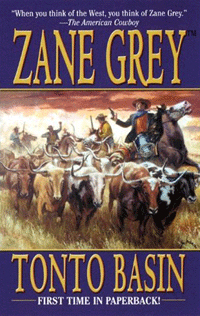
For the geographical place see Tonto Basin

Born to the West is a 1937 American Western film starring John Wayne, Marsha Hunt, and John Mack Brown. Filmed in black and white and based upon a Zane Grey novel, the movie incorporates footage from an earlier and higher budgeted silent version, a common practice of the era. The picture features fast chases, gun-fights, unusual poker gambling, and peppy light dialogue for the love interest.
"Nevada" is a 1928 Western novel by Zane Grey, a sequel to 1927's Forlorn River. Prior to its book publication it was serialized in seven issues of The American Magazine. The novel was adapted for films in 1927 and 1944.
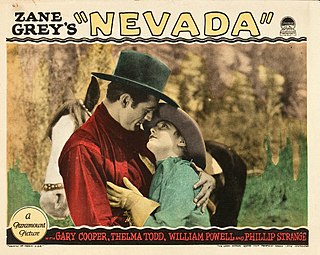
Nevada is a 1927 American silent Western film directed by John Waters and starring Gary Cooper, Thelma Todd, and William Powell. Based on the novel Nevada by Zane Grey, the film is about a former outlaw hired to protect a ranch owner's daughter, which angers the ranch foreman who is in love with the girl. The villainous foreman spreads a rumor of his rival's dark past to the sheriff, and the former outlaw is soon on the run again. Eventually he captures a gang of cattle rustlers led by the foreman, and with his reputation restored, he marries the girl. This lavish Western film was remade in 1944 as a B movie version titled Nevada starring Robert Mitchum—the only time Cooper and Mitchum played the same role; the remake was so early in Mitchum's career that he was billed with "Introducing Bob Mitchum as Jim Lacy."
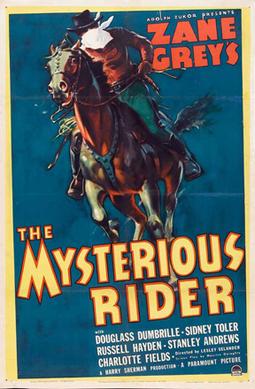
The Mysterious Rider is a 1938 American Western film directed by Lesley Selander and starring Douglass Dumbrille, Sidney Toler, and Russell Hayden. Written by Maurice Geraghty based on the 1921 novel The Mysterious Rider by Zane Gray, the film is about a notorious outlaw who returns to the ranch he once owned and takes a job disguised as a ranch hand. Unrecognized by the ranch's current owner, he waits patiently for an opportunity to expose the men who murdered his partner twenty years ago, framed him for the crime, and then stole his ranch. The film was later released for television in the United States as Mark of the Avenger.
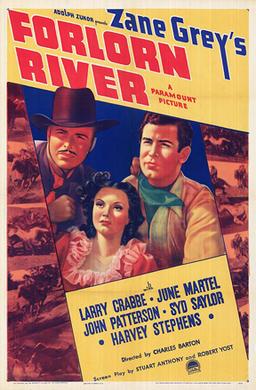
Forlorn River is a 1937 American Western film directed by Charles Barton and starring Buster Crabbe, June Martel, and Harvey Stephens. Based on the 1927 novel of the same name by Zane Grey.
Forlorn River is a 1926 American silent Western film directed by John Waters and written by Zane Grey and George C. Hull. The film stars Jack Holt, Raymond Hatton, Arlette Marchal, Edmund Burns, Tom Santschi, Joseph W. Girard and Christian J. Frank. It is based on the 1926 serialization of the 1927 novel Forlorn River by Zane Grey. The film was released on September 27, 1926, by Paramount Pictures.
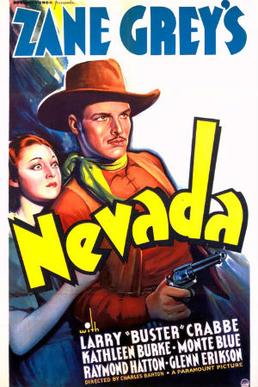
Nevada is a 1935 American Western film directed by Charles Barton and written by Garnett Weston and Stuart Anthony. It is based on the 1928 novel Nevada by Zane Grey. The film stars Buster Crabbe, Kathleen Burke, Syd Saylor, Monte Blue, William Duncan and Richard Carle. The film was released on November 29, 1935, by Paramount Pictures.

Lake Modoc is a former lake in California and Oregon, in the location of present-day Upper Klamath Lake, Lower Klamath Lake and Tule Lake. It existed during the Pliocene and Pleistocene epochs, its formation probably influenced by volcanism and faulting. The bed of the former lake had plentiful resources for early humans, and today it is used for agriculture.
















